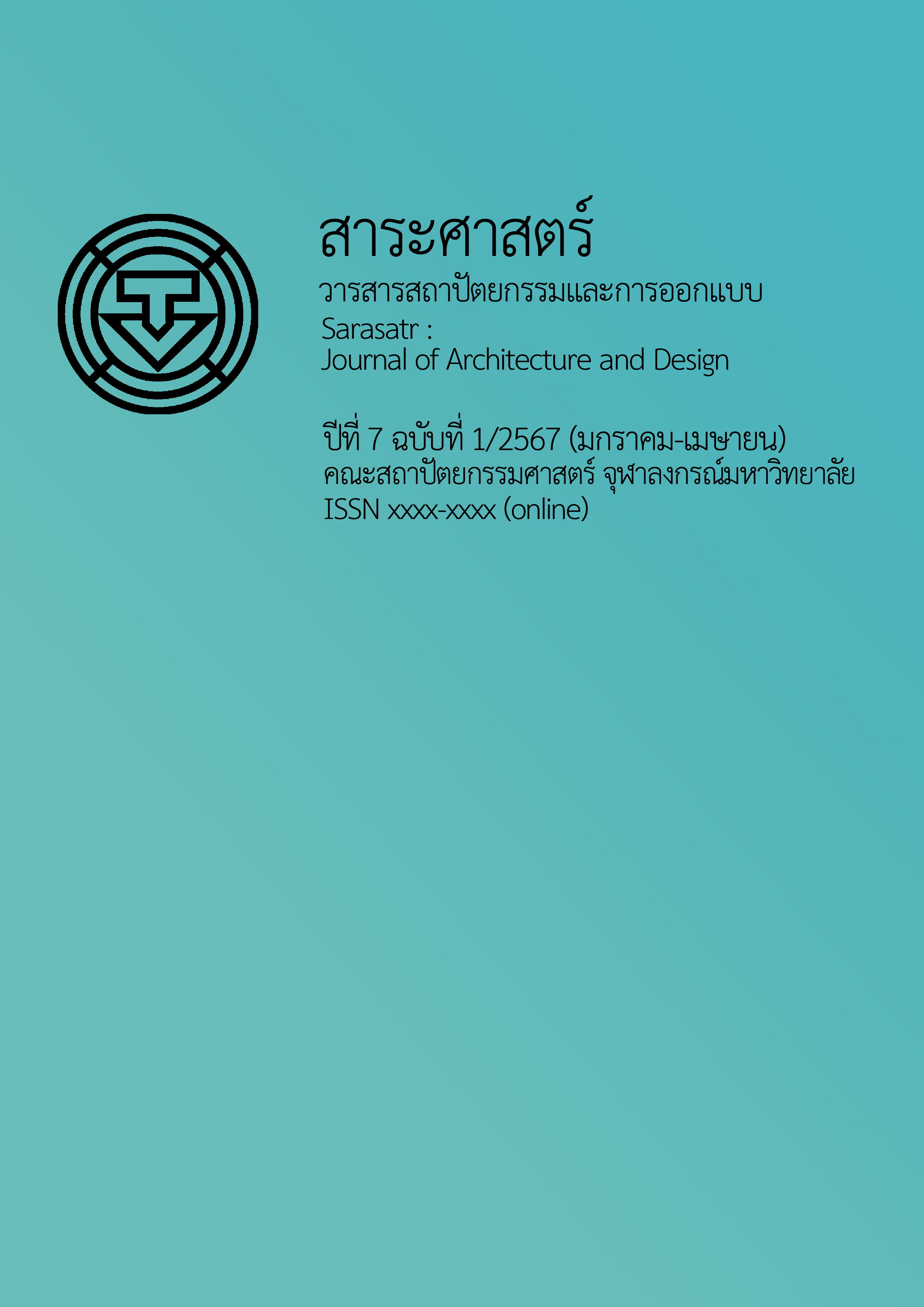การประยุกต์ใช้แบบจำลองสารสนเทศอาคาร 5 มิติ เพื่อปรับปรุงการถอดปริมาณงาน กรณีศึกษาโครงการก่อสร้างอาคารเรียนรู้และปฏิบัติการ 4 ชั้น
Main Article Content
บทคัดย่อ
เนื่องด้วยรูปแบบการถอดปริมาณงานและประมาณราคาก่อสร้าง ใช้ข้อมูลจากแบบก่อสร้างในรูปแบบ 2 มิติ
อาจเกิดความผิดพลาดจากการถอดปริมาณงาน เนื่องจากความไม่เข้าใจในการอ่านแบบก่อสร้างของผู้ถอดปริมาณงาน ส่งผลทำให้ปริมาณงานและราคาก่อสร้างที่ไม่ถูกต้อง ปัจจุบันได้มีการนำแบบจำลองสารสนเทศอาคารเข้ามาประยุกต์ใช้ในโครงการก่อสร้าง เพื่อจัดทำแบบก่อสร้าง สำหรับแสดงลักษณะทางกายภาพและแสดงข้อมูลในรูป 3 มิติ งานวิจัยนี้มีวัตถุประสงค์เพื่อนำเสนอการประยุกต์ใช้แบบจำลองสารสนเทศอาคาร 5 มิติ ที่ผสานข้อมูลมิติทางด้านแผนงานก่อสร้างและราคาค่าก่อสร้างเข้ากับแบบจำลอง 3 มิติ เพื่อปรับปรุงการถอดปริมาณงาน เปรียบเทียบความแตกต่างระหว่างปริมาณงานจากโปรแกรม Autodesk Revit และบัญชีแสดงปริมาณวัสดุและราคา (BOQ) สำหรับโครงการก่อสร้างอาคารเรียนรู้และปฏิบัติการ 4 ชั้น วิทยาลัยเทคนิคนครราชสีมา จากการศึกษาพบว่า การประยุกต์ใช้แบบจำลองสารสนเทศอาคาร 5 มิติ เพื่อการถอดปริมาณงานของโครงการก่อสร้าง สามารถลดระยะเวลาในการทำงาน ตรวจสอบความถูกต้องของแบบก่อสร้าง ลดข้อผิดพลาดจากการถอดปริมาณงาน สนับสนุนและเพิ่มความเข้าใจในการทำงานของผู้ประมาณราคาได้เป็นอย่างดี เมื่อเปรียบเทียบกับวิธีการวัดปริมาณงานก่อสร้างแบบเดิม จากการเปรียบเทียบความแตกต่างระหว่างปริมาณงานจากโปรแกรม Autodesk Revit และ บัญชีแสดงปริมาณวัสดุและราคา (BOQ) พบว่า เปอร์เซ็นต์ความแตกต่างเฉลี่ยของงานโครงสร้าง งานสถาปัตยกรรม และงานสุขาภิบาล มีค่าน้อยกว่า 2.69%, 4.12% และ 8.43% ตามลำดับ สามารถสรุปได้ว่า ปริมาณงานจากโปรแกรม Autodesk Revit มีความแม่นยำมากกว่า เนื่องจากวิธีการวัดปริมาณงานก่อสร้างแบบเดิม มีการวัดปริมาณงานซ้ำซ้อน เช่น การวัดปริมาณงานคอนกรีตโครงสร้าง ประกอบด้วย งานคอนกรีตพื้น คาน และเสา โดยที่โครงสร้างทั้ง 3 ส่วนซ้อนทับกัน ทำให้การวัดปริมาณงานซ้ำซ้อน แตกต่างกับปริมาณงานจากโปรแกรม Autodesk Revit ที่วัดปริมาณงานเฉพาะโครงสร้างแต่ละส่วน
Article Details
เอกสารอ้างอิง
กรมบัญชีกลาง. (2560). หลักเกณฑ์การคำนวณราคากลางงานก่อสร้างอาคาร. กรม.
กล้าศึก พรมฤทธิ์. (2553). การศึกษาปัญหาและอุปสรรคในการปฏิบัติงานของช่างโยธาในการกำหนดราคากลางงานก่อสร้าง ส่วนโยธา : กรณีศึกษาองค์การบริหารส่วนตำบลในอำเภอโนนไทย จังหวัดนครราชสีมา [วิทยานิพนธ์ปริญญามหาบัณฑิต ไม่ได้ตีพิมพ์]. มหาวิทยาลัยเทคโนโลยีสุรนารี.
ธนัชชา สุขขี. (2554). การศึกษาเลือกใช้แบบจำลองข้อมูลอาคารสำหรับอุตสาหกรรมก่อสร้างในประเทศไทย [วิทยานิพนธ์ปริญญามหาบัณฑิต ไม่ได้ตีพิมพ์]. มหาวิทยาลัยศิลปากร.
เพชร์รัตน์ ลิ้มสุปรียารัตน์, บุษบา ทวีโคตร, พงศธร โพธิ์คํา, และชาญยุทธ กาฬกาญจน์. (2565, 24-26 สิงหาคม). การเปรียบเทียบการคํานวณปริมาณวัสดุงานระบบสําหรับอาคารพักอาศัยด้วยแบบจําลองสารสนเทศอาคาร [เอกสารนำเสนอในที่ประชุม]. การประชุมวิศวกรรมโยธาแห่งชาติ ครั้งที่ 27 “วิศวกรรมโยธาเพื่อความเข้มแข็งของชุมชน.” โรงแรม เดอะ เฮอริเทจ, เชียงราย.
ภคศา จันทร์อุดม. (2560). แนวทางการใช้แบบจำลองสารสนเทศอาคาร (BIM) จัดการข้อมูลอาคารและแบบก่อสร้างจริง เพื่อดำเนินงานและการบำรุงรักษาอาคารสำนักงาน [วิทยานิพนธ์ปริญญามหาบัณฑิต ไม่ได้ตีพิมพ์]. มหาวิทยาลัย ธรรมศาสตร์.
ภากร ภัทราพรพิสิฐ. (2557). เครื่องมือประเมินการใช้งาน แบบจำลองสารสนเทศอาคาร (BIM) สำหรับอุตสาหกรรมก่อสร้างในประเทศไทย [วิทยานิพนธ์ปริญญามหาบัณฑิต ไม่ได้ตีพิมพ์]. มหาวิทยาลัยธรรมศาสตร์.
เมธาสิทธิ์ จันทร์พิทักษ์. (2564). การประยุกต์ใช้แบบจำลองสารสนเทศอาคาร เพื่อการถอดปริมาณและจัดการวัสดุผนังก่ออิฐ [วิทยานิพนธ์ปริญญามหาบัณฑิต ไม่ได้ตีพิมพ์]. จุฬาลงกรณ์มหาวิทยาลัย.
วสันต์ จำปาขาว. (2563). ปัจจัยที่มีผลต่อการกำหนดราคากลางงานก่อสรา้งของทางราชการ กรณีศึกษา หน่วยงานองค์กรปกครองส่วนท้องถิ่น จังหวัดปราจีนบุรี [วิทยานิพนธ์ปริญญามหาบัณฑิต ไม่ได้ตีพิมพ์]. มหาวิทยาลัยรามคำแหง.
สมาคมสถาปนิกสยาม ในพระบรมราชูปถัมภ์. (2558). คู่มือปฏิบัติวิชาชีพ แนวทางการใช้งานแบบจำลองสารสนเทศอาคาร สำหรับประเทศไทย (Thailand BIM Guideline). สมาคม.
สุริยวัชร พันธ์นรา, แหลมทอง เหล่าคงถาวร, และวัชระ เพียรสุภาพ. (2565, 24-26 สิงหาคม). การศึกษาอุปสรรคที่มีผลต่อการประยุกต์ใช้การ จัดจ้างโครงการแบบบูรณาการในอุตสาหกรรมการก่อสร้างของไทย [เอกสารนำเสนอในที่ประชุม]. การประชุมวิศวกรรมโยธาแห่งชาติ ครั้งที่ 27 “วิศวกรรมโยธาเพื่อความเข้มแข็งของชุมชน.” โรงแรม เดอะ เฮอริเทจ, เชียงราย.
AACE. (1997). Cost estimate classification system – as applied in engineering, procurement, and construction for the process industries. AACE International Recommended Practice No. 17R-97.
Ahuja, H., & Campbell, W. J. (1988). Estimating: From concept to completion. Prentice-Hall.
Brook, M. (2016). Estimating and tendering for construction work. Taylor & Francis.
BUILDEXT. (2022). What are the BIM dimensions? https://buildext.com/en/bim-dimensions/#:~:text =BIM%20dimensions%20are%20the%20use,5D%20(cost)
Campbell, B., & Humphrey, T. F. (1988). Methods of cost-effectiveness analysis for highway projects. NCHRP Synthesis of Highway Practice, (142). http://www.trb.org/Publications/Blurbs/154488.aspx
Eastman, C., Teicholz, P., Sack, R., & Liston, K. (2011). BIM handbook: A guide to building information, modeling for owners, designers, engineers, contractors, and facility managers (2nd ed.). John Wiley & Sons.
Grimstad, S., & Jørgensen, M. (2006, September 21-22). A framework for the analysis of software cost estimation accuracy. In ISESE06: ACM-IEEE International Symposium on Empirical Software Engineering 2006 (pp. 58-65). Rio de Janeiro, Brazil.
Lee, X. S., Tsong, C. W., & Khamidi, M. F. (2016). 5D building information modelling–a practicability review. MATEC Web of Conferences, 66, 00026. https://doi.org/10.1051/matecconf/20166600026
Salman, N., & Hamadeh, M. (2023). The Integration of Virtual Design and Construction (VDC) with the Fourth Dimension of Building Information Modeling (4D BIM). International Journal of BIM and Engineering Science (IJBES), 7(1), 08-27.
Sattineni, A., & Macdonald, J. A. (2014, July). 5D-BIM: A case study of an implementation strategy in the construction industy. In 2014 Proceedings of the 31st ISARC (The International Symposium on Automation and Robotics in Construction) (pp. 361-367). Sydney, Australia.
Stewart, R. D. (1991). Cost estimating. John Wiley & Sons.
Zayed, T. M., & Halpin, D. W. (2005). Pile construction productivity assessment. Journal of Construction Engineering and Management, 131(6), 705-714.


